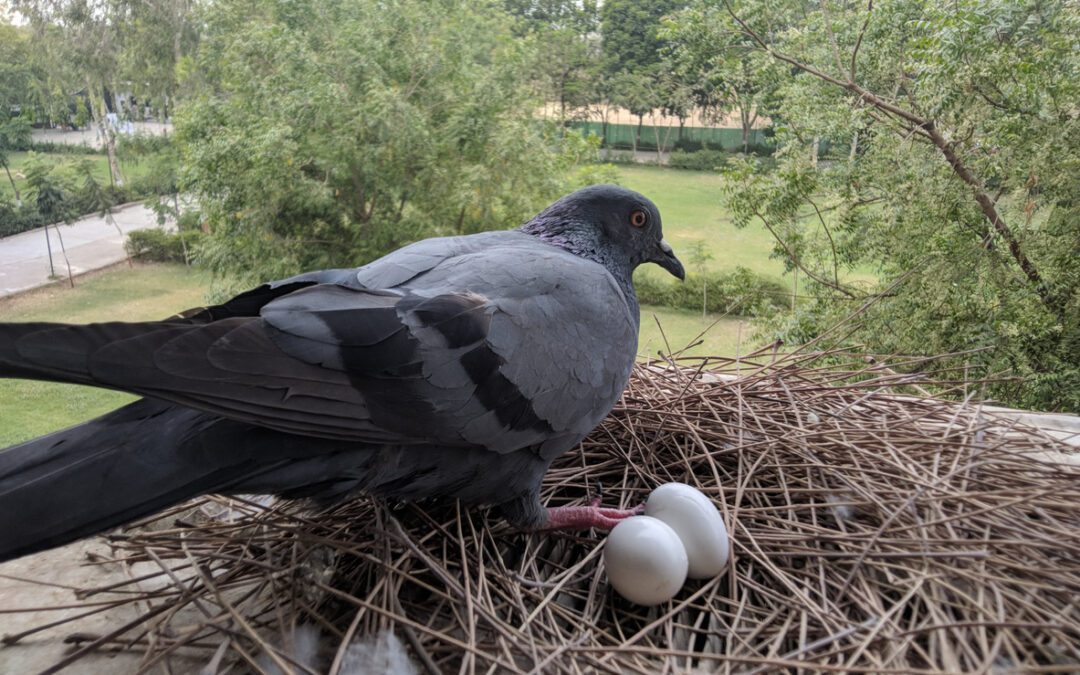
by Pigeon Patrol | Sep 19, 2024 | Bird Spike, Pigeons, Sparrows
Homing pigeons with their cryptic inborn GPS systems have been reliably delivering messages for at least three millennia. Pigeons announced the winners of ancient Olympiads. They delivered military messages for Genghis Khan and were the first to reach England with the outcome of the Battle of Waterloo. They’ve brought home the mail in war and peace. Many were awarded medals for distinguished service in World Wars One and Two.2 (No less amazing, of course, are the enormous migratory feats of other birds, but homing pigeons are easier to study because they travel on cue and not in response to the seasons.)
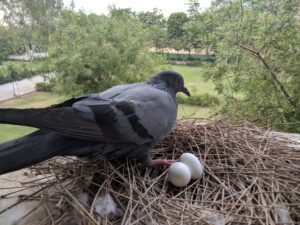
Pigeon With Egg in the nest photography. Birds Photography. Pigeon Hatching Eggs
And while “the magnetic sense of pigeons provides an excellent compass for orientation,” writes Hagstrum, “the geomagnetic field makes a poor map.”
Homing pigeons likely rely on a number of sensory cues to find their way home. While vision may be valuable locally, birds with frosted contact lenses manage to arrive after long trips to within 500 meters of their destination, so sight doesn’t seem to be the key.3 And while “the magnetic sense of pigeons provides an excellent compass for orientation,” writes Hagstrum, “the geomagnetic field makes a poor map.”4
The June 1997 pigeon disaster was one of four pigeon races disrupted in 1997 and 1998 in Europe and the northeastern United States. The only common element, as Hagstrum reported back in the year 2000, was the intersection of the racecourses with the path of an accelerating Concorde supersonic transport.5 This finding supported the idea that pigeons don’t achieve their precision long-distance navigation through reliance on vision or the earth’s magnetic field, since sonic booms disrupt neither. Yet the question remained: how do sonic booms disturb the birds’ natural abilities?
Hagstrum said, “When I realized the birds in that race were on the same flight path as the Concorde, I knew it had to be infrasound.” Infrasound is extremely low frequency sound generated by deep ocean waves. These waves cause tiny vibrations of planetary surfaces and atmosphere, called microseisms and microbaroms, respectively. Because of variations in terrain, infrasonic characteristics can form a map of the landscape.
Hagstrum’s latest study, published 15 February 2013 in the Journal of Experimental Biology, sorted through data on pigeon flights in upstate New York between 1968 and 1987 and confirmed that sonic boom disruption of the “sounds of silence” was likely responsible for the 1997 loss of over 60,000 trained birds. Moreover, his study represents a major piece for the how-birds-navigate puzzle.
The New York birds were part of a Cornell University experimental program. For nearly two decades researchers recorded that birds released from one of three standard sites—Jersey Hill—generally failed to make it home. Those from the other sites could find their way. Only once in those two decades did the Jersey Hill birds make it home to Cornell: on August 13, 1969. Meteorological records demonstrated that the area on that day experienced a temperature inversion. Hagstrum believes, based on acoustic modeling, that the terrain of the path between Jersey Hill and Cornell normally creates a “sound shadow,” obscuring the home loft by directing the infrasonic signals associated with it high into the atmosphere. On the one good day, differing atmospheric conditions would have made the infrasonic signals detectable to birds from Jersey Hill.6
Hagstrum believes that infrasonic signals from a home loft normally act like a homing beacon for birds to get their bearings as they orient using other signals such as the sun or stars, the earth’s magnetic field, and visual or olfactory clues.7 Ill-timed sonic booms, earthquakes, and terrain that coincidentally misdirects the sound waves as they propagate through the air all have the potential to disrupt infrasonic signals that normally bring these birds home.
You may listen to these subtle sounds yourself in amplified recordings from the University of Hawaii Infrasound Laboratory.8 As you listen, marvel at the ways God designed for birds to find their way using an earthward-directed GPS-like system for more than 6,000 years since creation.
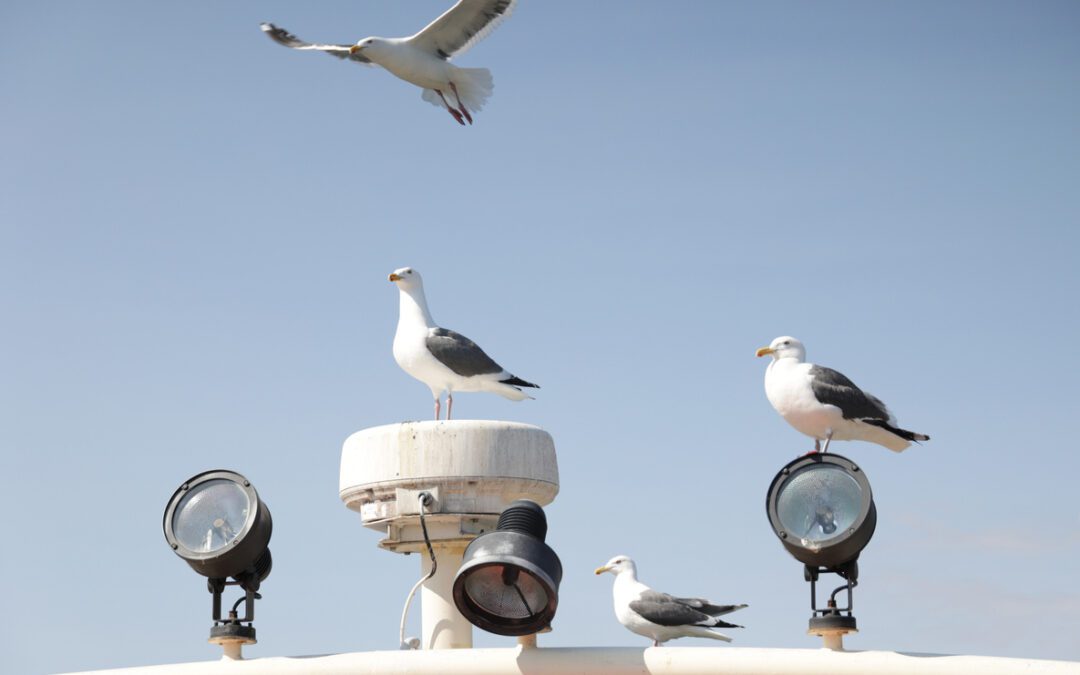
by Pigeon Patrol | Sep 19, 2024 | Bird Netting
It’s a modern mystery: how did 60,000 homing pigeons get lost between France and England on June 29, 1997, during the race commemorating the hundredth anniversary of the Royal Pigeon Racing Association? Unraveling the cause of this bizarre event, Jonathan Hagstrum of the U.S. Geological Survey may have finally filled in the pieces to the more ancient question of how these remarkable birds normally find their way home from distant unfamiliar places in all weather, day or night, in the first place.
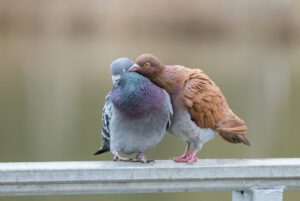
Feral pigeons (Columba livia domestica) in love.
Pigeon Patrol
Pigeon Patrol Products & Services is the leading manufacturer and distributor of bird deterrent (control) products in Canada. Pigeon Patrol products have solved pest bird problems in industrial, commercial, and residential settings since 2000, by using safe and humane bird deterrents with only bird and animal -friendly solutions. At Pigeon Patrol, we manufacture and offer a variety of bird deterrents, ranging from Ultra-flex Bird Spikes with UV protection, Bird Netting, 4-S Bird Gel and the best Ultrasonic and audible sound devices on the market today.
Canada’s top wholesaler for bird deterrent products for twelve consecutive years.
Contact us at 1- 877– 4– NO-BIRD, (604) 585-9279 or visit our website at https://www.pigeonpatrol.ca/
Bird Gone, Pigeon Gone, Pigeon problems, pigeon spikes, 1-877-4NO-BIRD, 4-S Gel, Bird Control, Pigeon Control, bird repellent, Bird Spikes, sonic bird repellent, stainless steel bird spikes, bird spikes Vancouver, Ultra Sonic Bird Control, Bird Netting, Plastic Bird Spikes, Canada bird spike deterrents, Pigeon Pests, B Gone Pigeon, Pigeon Patrol, pest controller, pest control operator, pest control technician, Pigeon Control Products, humane pigeon spikes, pigeon deterrents, pigeon traps, Pigeon repellents, Sound & Laser Deterrents, wildlife control, raccoon, skunk, squirrel deterrent, De-Fence Spikes, Dragons Den, Pigeon, Pigeon Patrol, Pigeons Roosting, Vancouver Pigeon Control, Bird Spikes, Bird Control, Bird Deterrent, Pigeon Deterrent, Surrey Pigeon Control, Pest, Seagull deterrent Vancouver Pigeon Blog, Birds Inside Home De-fence, Pigeon Nesting, Bird Droppings, Pigeon Dropping, woodpecker control, Keep The Birds Away, Birds/rats, seagull, pigeon, woodpecker, dove, sparrow, pidgeon control, pidgeon problem, pidgeon control, flying rats, pigeon Problems, bird netting, bird gel, bird spray, bird nails, bird guard, Pigeon control, Bird deterrents, Pigeon deterrents, Bird control, solutions, Pigeon prevention, Pigeon repellent, Bird proofing, Pest bird management, Pigeon spikes, Bird netting, Humane bird control, Bird exclusion, Urban bird control, Anti-roosting devices, Pigeon removal, Bird barriers
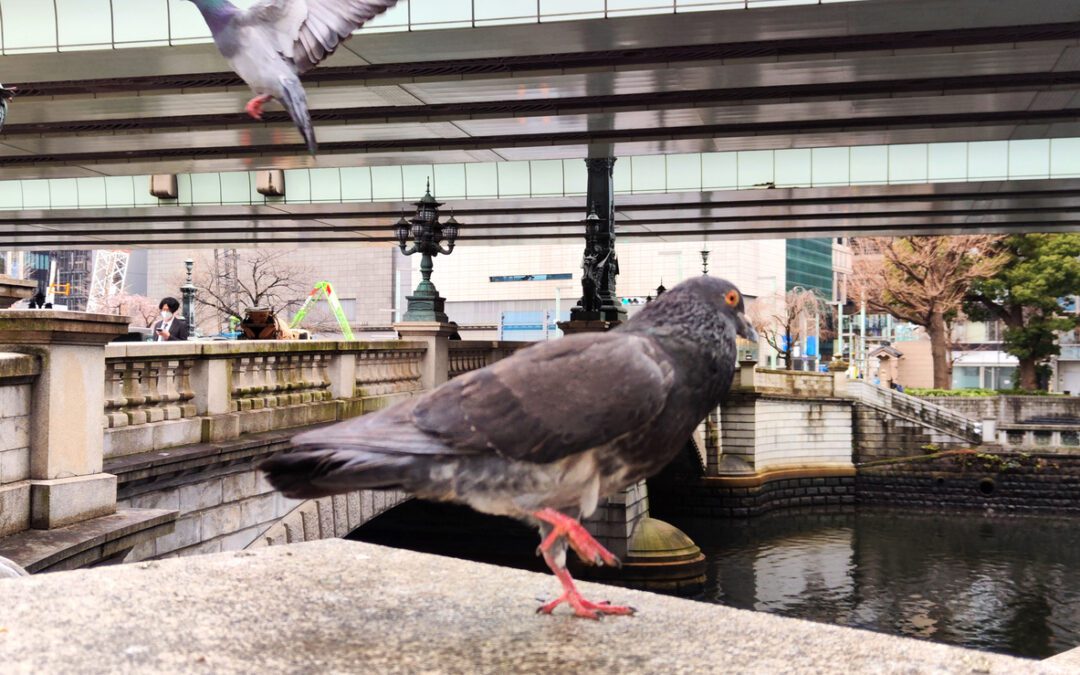
by Pigeon Patrol | Sep 19, 2024 | Bird Spikes, Columbidae, Doves
Passenger pigeons, so abundant during the early 19th century that skies darkened with passing flocks, may often have been nothing special in numbers during much of their last million years.
DNA from the extinct species, coaxed from toe pads of three museum specimens, suggests that population numbers fluctuated in the long term. The breeding population could have been at times only roughly several hundred thousand or even just tens of thousands of birds, says Chih-Ming Hung of National Taiwan Normal University in Taipei.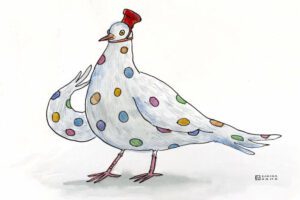
That’s a surprise. A survey of various other animals suggests that the size of the breeding population, like that pulled from the pigeon DNA, is typically about one-tenth of the whole population, Hung says. Yet the estimates of breeding populations in the new study are only one ten-thousandth of the 3 billion to 5 billion birds estimated in 19th-century eyewitness reports.
Hung doesn’t dispute those huge 19th century estimates. The DNA tells a story of bird numbers that soared and sank over time, he and his colleagues argue June 16 in the Proceedings of the National Academy of Sciences. He would need more analysis, he says, to see if an extreme crash during the most recent Ice Age would have produced such a skewed ratio in the last century. Or, in a more controversial scenario, he proposes that passenger pigeons may have had population booms and busts repeatedly on much shorter time scales.
Hung became curious about genetic trends of the passenger pigeon after a pivotal conversation several years ago regarding the 100th anniversary this September of the death of Martha, a passenger pigeon in the Cincinnati Zoo and the last known individual of the species.
Museum specimens’ toe pads provide the best picture yet of passenger pigeon genetics, Hung says. From the amount of variation the researchers found in the specimens’ DNA, they could work out an approximate number for the birds that were passing on their genes, called the effective population size.
Over the last million years, Hung and his colleagues found, the typical number of breeding birds could have averaged something like 330,000. Another method found lower numbers but a similarly small order of magnitude: 170,000 at the population’s height to perhaps 50,000 at its worst. The ups and downs over deep history fit with the timing of glacial cycles and with computer simulations of the niches available for the birds as climate changed.
Genetic tests can’t detect population ups and downs at the scale of a mere century. But Hung and his colleagues speculate that pigeon populations might have fluctuated in the short term too, perhaps shrinking drastically during times of skimpy acorns.
In theory, a species that surges in mind-boggling numbers certainly can go extinct quickly, says entomologist Jeffrey A. Lockwood of the University of Wyoming. The Rocky Mountain locust (Melanoplus spretus) is an example that savaged wide swaths of cropland during its booms but abruptly went extinct at the end of the 19th century when farmers took over the very specific habitats it needed to breed.
But passenger pigeons couldn’t have boomed in huge numbers quickly, says conservation biologist Stanley Temple of the University of Wisconsin–Madison. The birds tended just one nest a year and raised one chick. “There is absolutely no way these birds could rapidly increase their numbers,” he says. “It would take them probably centuries to increase their population even tenfold, let alone several orders of magnitude.”
Hung and critics agree that natural cycles, either short- or long-term, do not mean that the passenger pigeon would have eventually cycled into oblivion on its own. David Blockstein, senior scientist at the National Council for Science and the Environment in Washington, D.C., has described how intensive shooting at breeding colonies contributed to the species’ demise by disrupting its reproduction. And ecologist Stuart Pimm of Duke University says, “The basic cause for the passenger pigeon’s decline was the destruction of the Eastern forests.” The message of the paper, Hung says, is that “the passenger pigeon had repeatedly recovered from population lows throughout its history.” Then came 19th-century humans.
Pigeon Patrol
Pigeon Patrol Products & Services is the leading manufacturer and distributor of bird deterrent (control) products in Canada. Pigeon Patrol products have solved pest bird problems in industrial, commercial, and residential settings since 2000, by using safe and humane bird deterrents with only bird and animal -friendly solutions. At Pigeon Patrol, we manufacture and offer a variety of bird deterrents, ranging from Ultra-flex Bird Spikes with UV protection, Bird Netting, 4-S Bird Gel and the best Ultrasonic and audible sound devices on the market today.
Canada’s top wholesaler for bird deterrent products for twelve consecutive years.
Contact us at 1- 877– 4– NO-BIRD, (604) 585-9279 or visit our website at https://www.pigeonpatrol.ca/
Bird Gone, Pigeon Gone, Pigeon problems, pigeon spikes, 1-877-4NO-BIRD, 4-S Gel, Bird Control, Pigeon Control, bird repellent, Bird Spikes, sonic bird repellent, stainless steel bird spikes, bird spikes Vancouver, Ultra Sonic Bird Control, Bird Netting, Plastic Bird Spikes, Canada bird spike deterrents, Pigeon Pests, B Gone Pigeon, Pigeon Patrol, pest controller, pest control operator, pest control technician, Pigeon Control Products, humane pigeon spikes, pigeon deterrents, pigeon traps, Pigeon repellents, Sound & Laser Deterrents, wildlife control, raccoon, skunk, squirrel deterrent, De-Fence Spikes, Dragons Den, Pigeon, Pigeon Patrol, Pigeons Roosting, Vancouver Pigeon Control, Bird Spikes, Bird Control, Bird Deterrent, Pigeon Deterrent, Surrey Pigeon Control, Pest, Seagull deterrent Vancouver Pigeon Blog, Birds Inside Home De-fence, Pigeon Nesting, Bird Droppings, Pigeon Dropping, woodpecker control, Keep The Birds Away, Birds/rats, seagull, pigeon, woodpecker, dove, sparrow, pidgeon control, pidgeon problem, pidgeon control, flying rats, pigeon Problems, bird netting, bird gel, bird spray, bird nails, bird guard, Pigeon control, Bird deterrents, Pigeon deterrents, Bird control, solutions, Pigeon prevention, Pigeon repellent, Bird proofing, Pest bird management, Pigeon spikes, Bird netting, Humane bird control, Bird exclusion, Urban bird control, Anti-roosting devices, Pigeon removal, Bird barriers
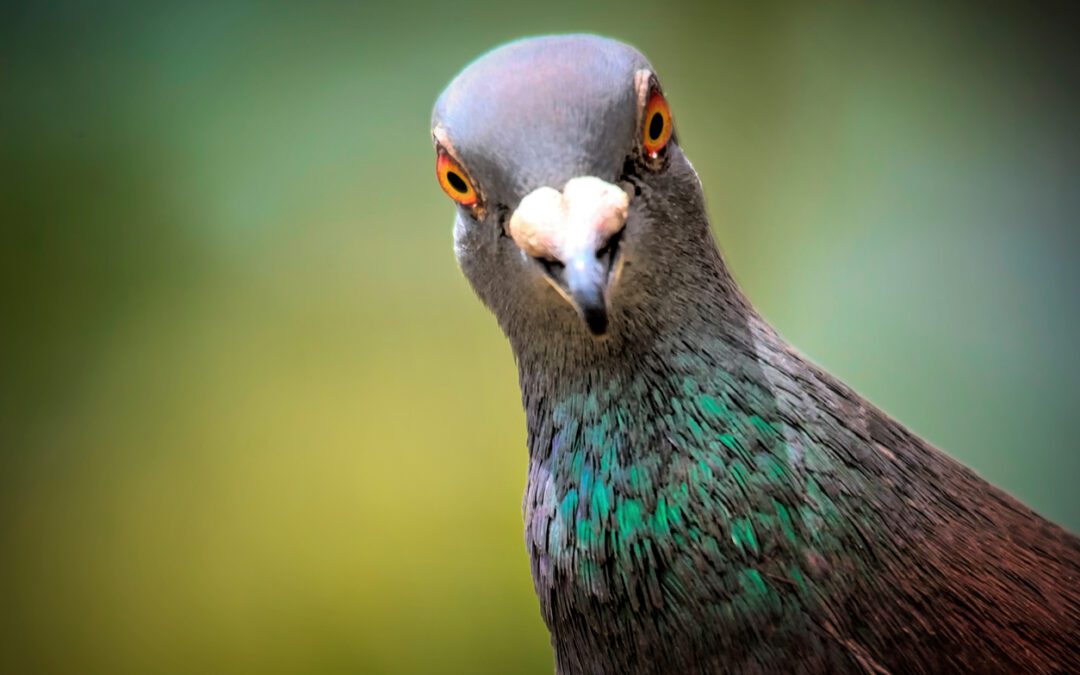
by Pigeon Patrol | Sep 19, 2024 | Bird Spike, Pigeon Predators, Pigeon Spikes
I LIKE pigeons. Their voices are soft and rhythmic. I have put up baskets for them in the front verandah and they live there quietly. They don’t ask for food – probably because they are fed at the roundabout near my house by compassionate people who come from far to drop grains for them every day. I have a bird table of rice and fruit so they can feed there whenever they want.
The Mumbai Municipal Commissioner has made it the feature of his (hopefully brief) tenure that he will get rid of the pigeons from Mumbai. Those who go looking for something to hate and often pick on pigeons should know what they have done for us humans over the years.
The first airmail using pigeons was established in 1896 in New Zealand and was known as the Pigeon-Gram Service. Their speed averaged 77.6 mph, only 40% slower than a modern aircraft. Each pigeon carried 5 messages and special Pigeon-Gram stamps were sold for each message carried.
In the First World War, pigeons were used extensively for carrying messages. German marksmen were deployed to shoot the birds down. Pigeons were carried in tanks and released through tiny portholes in the side. Mine-sweeping boats carried pigeons so that in the event of an attack by a U-boat, a pigeon could be released with a message confirming the exact location of the sinking boat, often resulting in the crew being saved. Seaplanes carried pigeons to relay urgent information about enemy movements. In the Second World War, pigeons were used in active service in Europe, India and Burma.
The last pigeon messaging service in the world was in Odisha called Orissa Police Carrier Pigeon Service and it disbanded in 2006 after 60 years of active service and 800 birds. Carrier pigeons had provided daily communications between Orissa’s 400 police stations across the state. They carried essential messages during two natural disasters: the massive cyclone in 1971 and the unprecedented floods in 1982. Their ability to fly in adverse weather conditions saved many human lives.
Read Also
Impressive Voter Turnout In J&K Shows People’s Strong Trust In Democracy: Amit Shah
Influence Of Social Media On Golf’s Popularity In Post-Pandemic World
In the 5th century BC the first network of pigeon messengers is thought to have been established in Assyria and Persia by Cyrus the Great. In 2000 BC they were carrying messages to warring groups in Mesopotamia. In 53 B.C they carried Hannibal’s dispatches. Julius Caesar used pigeons during the conquest of Gaul from 58 to 51 BC. Indian and Arab merchants used carrier pigeons when visiting China. At the first Olympic Games held in 776 BC, every athlete had a homing pigeon from his village. If he won his event, his would be the bird that carried the news home.
Between 63 BC – AD 21, the Greek geographer Strabo noted that pigeons flew between certain points along the Mediterranean coastline to carry messages of the arrival of fish shoals for waiting fishermen.
The news agency Reuters originally used pigeons to disseminate news in the 1840s. Paul Julius Reuter’s pigeons only stopped when the telegram was invented. In 1870 they carried messages throughout France during the siege of Paris.
In 1915, at the start of the First Great War, two Pigeon Corps were established on the Western Front, consisting of 15 pigeon stations each with 4 birds and a handler. The Pigeon Corps was so successful that further birds were recruited, and the service expanded considerably. By the end of the war the Pigeon Corps consisted of 400 men and 22,000 pigeons in 150 mobile lofts. Messages would be put into a small canister and then attached to the pigeon’s leg. The bird would be released and would return to its loft behind allied lines, sounding a bell to confirm that it had landed. Each airfield along the coast of England had its own loft so that pigeons could be dispatched with messages in the event of invasion. Bomber crews usually carried a pair of pigeons so that in the event that the plane was shot down, the birds could be released with details of the crash site.
These birds played a major role in the Intelligence Service in the First World War. They were sent to maintain contact with resistance movements across Europe. Fewer than 10% survived the shell fire, small arms fire, poison gas.
In 1940, 300 crates of pigeons were dropped into Enemy-occupied areas of Europe, each bird being packed into a box with food for 10 days. Instructions and a questionnaire were put in the box. If found by an ally, information about enemy movement could be put inside the container on the bird’s leg and the bird released to fly back. 16,544 pigeons were parachuted into occupied Europe during the Second Great War. Only 1,842 returned.
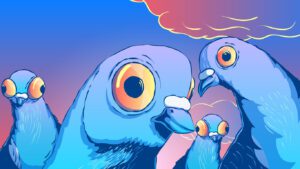
Hand-drawn funny cute illustration – Curious pigeons.
Over 1,00,000 British pigeons lost their lives in military service. Red Cock flew back a torpedoed trawler carrying the grid reference of the sinking boat and saving the crew. In October 1918, 500 men of the 77th Infantry were trapped in Argonne, France with no food or ammunition and being bombarded by their own side. The major sent the pigeon Cher Ami with a message for rescue. The bird was shot through the breast by enemy fire and fell to the ground. She got back into the air and flew 25 miles back to Division Headquarters in 25 minutes. The men were saved. Cher Ami had delivered the message despite having been shot through the breast, blinded in one eye and with a leg hanging by only a tendon. The Dickin medal is awarded to any animal that has distinguished itself through an act of bravery in wartime. Of the 55 medals awarded to date, pigeons have been recognized 32 times- much less than they deserve because they saved the lives of lakhs of people. The American and Australian Services also used pigeons extensively and had their own pigeon units operating indifferent countries. So did Burma (Myanmar) and India.
Some years ago, the Indian army captured a pigeon carrying a message from the Pakistan army.
Pigeons were used for aerial photography. A miniature camera was mounted to the bird’s breast via a canvass harness and the pigeon sent to areas of strategic importance to capture images. The films provided information about enemy troop movements and air bases. Information relating to exact positions of the V1 flying bomb site in Peenemunde in Germany was conveyed by pigeons – information that turned the tide of the war.
In 2004 an impressive memorial to commemorate all the animals and birds killed during wartime was erected in Hyde Park. Pigeons have been given pride of place in the sculpture with two pack mules in the foreground weighed down with munitions and cannon parts.
Pigeons more than any other animal have been man’s best friend in times of crisis. They give of themselves for a just a handful of grain. You need to repay your debt every day.
Pigeon Patrol
Pigeon Patrol Products & Services is the leading manufacturer and distributor of bird deterrent (control) products in Canada. Pigeon Patrol products have solved pest bird problems in industrial, commercial, and residential settings since 2000, by using safe and humane bird deterrents with only bird and animal -friendly solutions. At Pigeon Patrol, we manufacture and offer a variety of bird deterrents, ranging from Ultra-flex Bird Spikes with UV protection, Bird Netting, 4-S Bird Gel and the best Ultrasonic and audible sound devices on the market today.
Canada’s top wholesaler for bird deterrent products for twelve consecutive years.
Contact us at 1- 877– 4– NO-BIRD, (604) 585-9279 or visit our website at https://www.pigeonpatrol.ca/
Bird Gone, Pigeon Gone, Pigeon problems, pigeon spikes, 1-877-4NO-BIRD, 4-S Gel, Bird Control, Pigeon Control, bird repellent, Bird Spikes, sonic bird repellent, stainless steel bird spikes, bird spikes Vancouver, Ultra Sonic Bird Control, Bird Netting, Plastic Bird Spikes, Canada bird spike deterrents, Pigeon Pests, B Gone Pigeon, Pigeon Patrol, pest controller, pest control operator, pest control technician, Pigeon Control Products, humane pigeon spikes, pigeon deterrents, pigeon traps, Pigeon repellents, Sound & Laser Deterrents, wildlife control, raccoon, skunk, squirrel deterrent, De-Fence Spikes, Dragons Den, Pigeon, Pigeon Patrol, Pigeons Roosting, Vancouver Pigeon Control, Bird Spikes, Bird Control, Bird Deterrent, Pigeon Deterrent, Surrey Pigeon Control, Pest, Seagull deterrent Vancouver Pigeon Blog, Birds Inside Home De-fence, Pigeon Nesting, Bird Droppings, Pigeon Dropping, woodpecker control, Keep The Birds Away, Birds/rats, seagull, pigeon, woodpecker, dove, sparrow, pidgeon control, pidgeon problem, pidgeon control, flying rats, pigeon Problems, bird netting, bird gel, bird spray, bird nails, bird guard, Pigeon control, Bird deterrents, Pigeon deterrents, Bird control, solutions, Pigeon prevention, Pigeon repellent, Bird proofing, Pest bird management, Pigeon spikes, Bird netting, Humane bird control, Bird exclusion, Urban bird control, Anti-roosting devices, Pigeon removal, Bird barriers
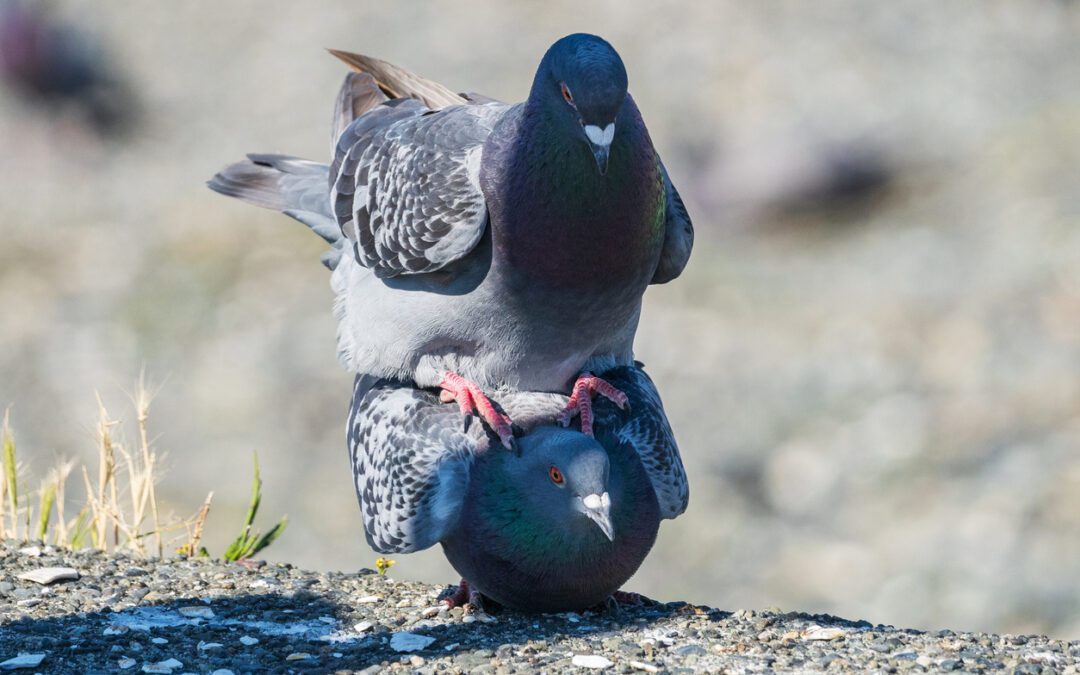
by Pigeon Patrol | Sep 19, 2024 | Bird Law, Bird Netting, Bird Spikes, Columbidae
If you’ve been around Ryerson, chances are that you have heard of, or maybe even got the chance to see, the one-legged pigeon. This famous icon is well-known for roaming the campus, along with being one of the school’s greatest memes.
When The Eye spoke with the pigeons five years ago, there were reports of a second wave of the Pigeons’ Movement. Recently, we have been in contact with some inside voices. After deciphering their coo-coos and squawks, it turns out that the second wave Pigeons’ Movement fell through because the leading figure went missing—the one-legged pigeon.
To get to the bottom of this, I set out to find her. It would be no easy task—the only way to do that is to explore every inch of Ryerson. Her Twitter hasn’t been updated since 2014. While searching around campus, I encountered many pigeons. But to the demise of the entire student body, all these pigeons had two legs.
All of the pigeons were quite strange. There were many different pigeons—concrete pecking, bread pecking, aggressive wing flapping. None of the pigeons could even gracefully win in a breadcrumb fight. The pigeon community has really taken a hit since this tragedy struck.
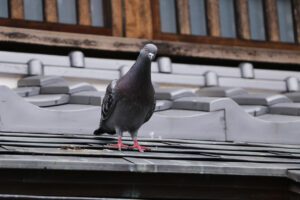
I asked the pigeons if they knew anything about the word on the street, but none had any useful information. It seems as though the pigeon’s movement is no longer birds of a feather. Actually, some of them even seemed bird-brained.
The regular day-to-day pigeons weren’t much help, but we searched the dustiest of alleyways and found a lone pigeon smoking a cigarette and wearing a trenchcoat.
After demanding a payment of seven Ritz crackers, he told us one of his feathered associates received a telepathic message that the one-legged pigeon is still alive, and is planning something big. We still don’t know if what the mysterious pigeon’s associate’s friend said was reliable or true. Due to not wanting to suffer an Alfred Hitchcock-esque death and get picked to pieces by the pigeons, we did not press further.
For now, unfortunately, the one-legged pigeon is still missing. Alas, I still have hope. I won’t stop working on this story. I’m willing to bet my last One Card dollars that Ryerson will be blessed with the return of this legend.
Pigeon Patrol
Pigeon Patrol Products & Services is the leading manufacturer and distributor of bird deterrent (control) products in Canada. Pigeon Patrol products have solved pest bird problems in industrial, commercial, and residential settings since 2000, by using safe and humane bird deterrents with only bird and animal -friendly solutions. At Pigeon Patrol, we manufacture and offer a variety of bird deterrents, ranging from Ultra-flex Bird Spikes with UV protection, Bird Netting, 4-S Bird Gel and the best Ultrasonic and audible sound devices on the market today.
Canada’s top wholesaler for bird deterrent products for twelve consecutive years.
Contact us at 1- 877– 4– NO-BIRD, (604) 585-9279 or visit our website at https://www.pigeonpatrol.ca/
Bird Gone, Pigeon Gone, Pigeon problems, pigeon spikes, 1-877-4NO-BIRD, 4-S Gel, Bird Control, Pigeon Control, bird repellent, Bird Spikes, sonic bird repellent, stainless steel bird spikes, bird spikes Vancouver, Ultra Sonic Bird Control, Bird Netting, Plastic Bird Spikes, Canada bird spike deterrents, Pigeon Pests, B Gone Pigeon, Pigeon Patrol, pest controller, pest control operator, pest control technician, Pigeon Control Products, humane pigeon spikes, pigeon deterrents, pigeon traps, Pigeon repellents, Sound & Laser Deterrents, wildlife control, raccoon, skunk, squirrel deterrent, De-Fence Spikes, Dragons Den, Pigeon, Pigeon Patrol, Pigeons Roosting, Vancouver Pigeon Control, Bird Spikes, Bird Control, Bird Deterrent, Pigeon Deterrent, Surrey Pigeon Control, Pest, Seagull deterrent Vancouver Pigeon Blog, Birds Inside Home De-fence, Pigeon Nesting, Bird Droppings, Pigeon Dropping, woodpecker control, Keep The Birds Away, Birds/rats, seagull, pigeon, woodpecker, dove, sparrow, pidgeon control, pidgeon problem, pidgeon control, flying rats, pigeon Problems, bird netting, bird gel, bird spray, bird nails, bird guard, Pigeon control, Bird deterrents, Pigeon deterrents, Bird control, solutions, Pigeon prevention, Pigeon repellent, Bird proofing, Pest bird management, Pigeon spikes, Bird netting, Humane bird control, Bird exclusion, Urban bird control, Anti-roosting devices, Pigeon removal, Bird barriers










